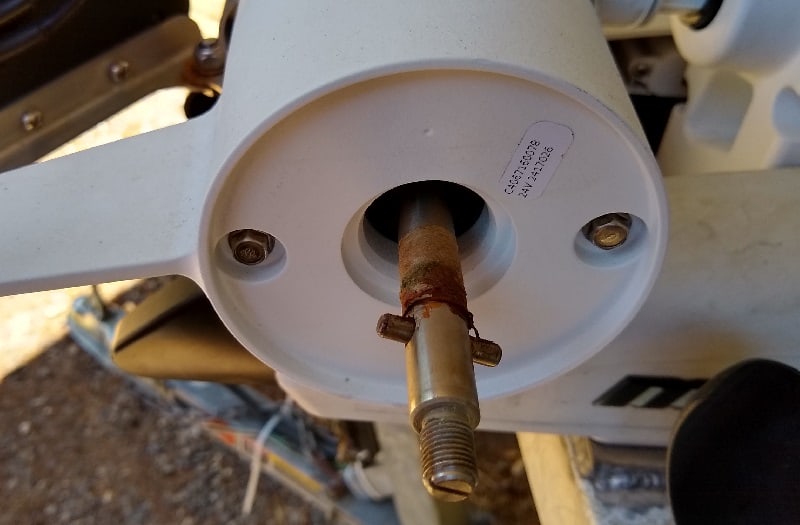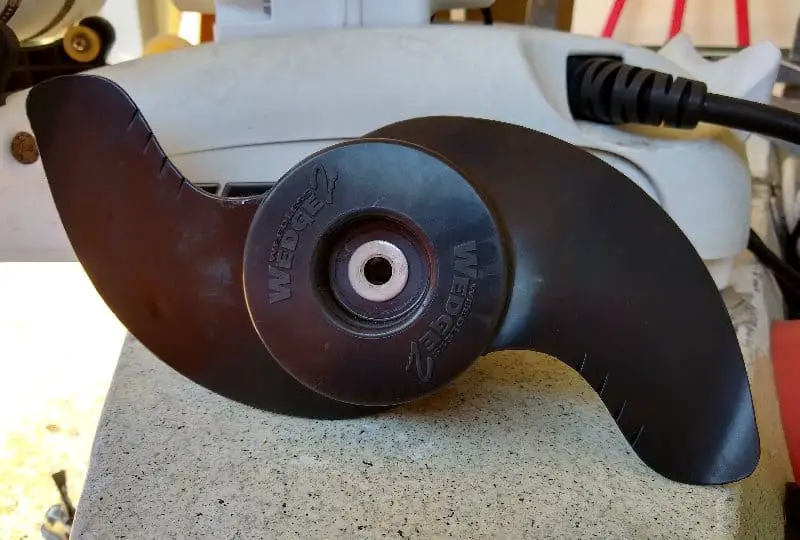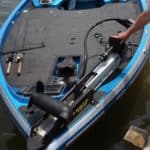When comparing the Kipawa three blade prop against the OEM Minn Kota Wedge2 prop, the Kipawa prop has a better top speed while the Minn Kota prop seemed to be more responsive than the Kipawa prop. So, if you are looking for more speed the Kipawa three blade propeller is a better option.
In this post, I am going to take a look at the Kipawa three blade prop compared to the OEM Minn Kota Wedge2 prop. And then we will talk a little about maintenance.
Note: most links in this article are Amazon.com Affiliate links, see Affiliate Disclosure, thank you.
Comparing the propellers:
I wanted to compare a few different factors with these propellers. My motor is a Minn Kota Riptide 80lb 24volt with I-pilot Link on a 19-foot aluminum Jetcraft (currently Kingfisher). I have the factory OEM prop and just purchased the Kipawa 3 blade 80/01. My main reason for buying this prop was for comparing the leading propellers. I cover propeller performance in today’s post on these factors, and then I will discuss propellers.
- Speed (low, high)
- Response time
- Noise level
- Battery consumption
The first performance I wanted to test was speed. My normal trolling speed is 3.5 on my Minn Kota remote which moves my boat at 1.3mph on a calm lake. I switched out the prop and installed the Kipawa three blade and was bouncing just above 1.4mph. I considered this a noticeable difference.
The next test I did was full speed, the Kipawa prop was running about 3.7mph, and the Minn Kota prop was running around 3.4. It is a 10% increase in top speed, which was shocking to me. I thought it was important to note the voltage so I ran the voltage on a digital meter with my fresh battery bank and both props had the same voltage of 12.4, I didn’t bring my ammeter, oops.
Something else I noticed was response time when I took the motor from a dead stop to full power it didn’t seem to jump as quickly with the Kipawa prop. The Kipawa prop seemed to make less noise at full speed, the motor still had the same hum, but the prop was smoother in the water.
The theme of my day was “time to change the prop,” I must have changed them out five times. I double-checked the startup speed, and the Minn Kota prop responded more quickly.
I would like to know If the Kipawa prop used less battery power. I am going to have to make an assumption based on my tests. Normally I run my motor on speed setting 3.5, I am going to fish at setting 3, and I expect to have a 10% increase in battery time.
Summary:
The Kipawa three blade prop and the OEM Minn Kota Wedge2 prop are both good props. The Kipawa prop is faster and smoother than the Minn Kota Prop. I think those attributes will make the Kipawa prop a better prop for a day of lake trolling.
The Minn Kota prop has more punch, a quicker response. I think that in a bass fishing environment the Minn Kota prop might be better because of the quick response and it claims to be a weedless prop, but I can’t verify.
If I wasn’t that guy that has to have the toys, I could skip this purchase. If you need a new prop because you broke or damaged your current OEM prop, then I say buy the Kipawa prop if you do a lot of trolling. Here is a link to the Kipawa prop I purchased on Amazon.com, make sure to match your motor to the right prop.
Is it hard to change a propeller on an electric trolling motor?
It is easy to remove a propeller on most electric trolling motors. The tools I needed to remove the prop on my electric trolling motor were a 9/16 open-end wrench and a medium-size flat tip screwdriver.

Place the screwdriver in the slot on the end of the propeller shaft. Put the open-end wrench on the nylock prop nut. Then you remove the nut by bolding the screwdriver firmly and turning the prop nut counter-clockwise. Pull on the prop to remove it from the shaft. If the prop doesn’t come off lightly tap on each blade with a rubber mallet until it pops loose.
It is a great time to clean your prop shaft off of grass or fishing line. Then you can install your new prop in reverse order. After you secure your prop nut, you can torque it to 30-foot-pounds. If you don’t have a torque wrench nylock nuts are good at staying stationary so make it reasonably tight.
If you are maintaining your prop for anything more than cleaning you should remove it, so you don’t damage your motor seals on your prop shaft.
How do I adjusting my skeg?
When you have your prop off of your motor is the perfect time to adjust your skeg. Your skeg should stay in position unless you hit a large object underwater like a rock or drop your motor at some point.
Most electric trolling motors have the skeg cast as a separate adjustable part of the lower unit housing. Behind your propeller are two bolts, loosen but do not remove them because this is part of the motor assembly. Adjust your skeg until it is in line with your motor shaft and tighten the bolts to secure.
Maintaining your prop or fixing chips:
If your propeller’s leading-edge is beaten up, you can take tune it up. I start by placing the prop upside down on my workbench, and with a regular metal file, not a course file, I file the leading edge of each blade, starting from the center and working to the tip. After I have completed that process, I flip the prop over and start again from the center to the tip of each blade.
For the last step, I take some 200 grit wet/dry sandpaper, wet it, fold it, and lightly sand both sides of each blade in a pulling motion from the center to the tip. Now you have a sharp prop that will increase speed and battery efficiency.



